Celebration of Basketry and Native Foods - Presenter Biographies
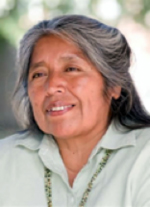
Ofelia Zepeda, PhD
Ofelia Zepeda, (Tohono O'odham), PhD is Regents’ Professor of linguistics at the University of Arizona and co-founder of the nationally recognized American Indian Language Development Institute at the University of Arizona. She has been director of the Institute since 1989. She is a Native speaker and preservationist of the Tohono O'odham language. Professor Zepeda has published numerous works on the Tohono O'odham language based on her own fieldwork. In addition to her work on the Tohono O'odham language, Professor Zepeda has published and edited works on American Indian language issues, dialect variation, language preservation and Native American literature. She has won awards for her community outreach projects and for her service to graduate students. Poet in both Tohono O'odham and English, her poems have been published in two books and in anthologies. Professor Zepeda is a member of the VOVA Advisory Board.
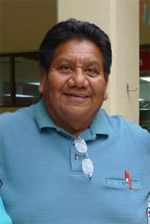
Bernard Siquieros, Tohono O'odham
Bernard G. Siquieros is an enrolled member of the Tohono O'odham Nation currently employed as the Curator of Education at Himdag Ki: Hiking, Hemu, Im B I-Ha’ap, the Tohono O'odham Nation’s Cultural Center and Museum. Previous to his current position, as Project Administrator, he was responsible for the coordination of all aspects leading to the completion of the Tohono O'odham Nation’s Cultural Center and Museum Project. Mr. Siquieros has served as counselor, researcher, program coordinator, and education administrator in education entities on and off the Tohono O'odham Nation. He is an avid photographer and has contributed immensely to the tribe’s photo documentation efforts at Himdag Ki.
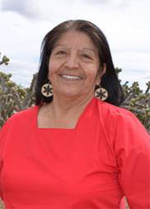
Regina Siquieros, Tohono O'odham
Regina L. Siquieros in an enrolled member of the Tohono O'odham Nation. In addition to her 29 years as a classroom teacher she has coordinated substance abuse programs, has served as the senior coordinator for the American Indian Languages Development Institute (AILDI) at the University of Arizona, and as a government affairs assistant for the Chairman and Vice Chairwoman of the Tohono O'odham Nation. Her extensive knowledge of the O'odham culture is exemplified by the traditional songs and stories she shares with both O'odham and non O'odham audiences.
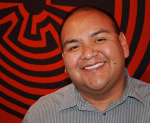
Terrol Dew Johnson
Co-Founder, President & C.E.O. of the Tohono O'odham Community Action
Terrol Johnson is a community leader, nationally recognized advocate for Native communities and renowned artist.
In 1996, Terrol co-founded Tohono O'odham community Action (TOCA), a grassroots community organization dedicated to creating positive programs based in the O'odham Himdag-the Desert People’s Way. In 2002, Terrol and TOCA Co-Director Tristan Reader were recognized as one of the nation’s top leadership teams when they received the Ford Foundation’s Leadership for a Changing World Award. Terrol’s collaborations range from museum exhibitions to documentaries and book publications. In October 1999, Terrol was named one of “America’s top ten young community leaders” by the Do Something Foundation. In 2009-10, Terrol walked from Maine to Arizona as a part of The Walk Home: A Journey to Native Wellness, bringing awareness to the crisis of Diabetes in Native communities and highlighting the ways in which communities have the capacity to create wellness by drawing upon their rich cultural traditions.
As an artist, Terrol began learning to weave baskets in school when he was just ten years old. He is now recognized as one of the top Native American basketweavers in the U.S. He has won top honors at such shows as Santa Fe Indian Market, O'odham Tash, the Heard Museum Fair and the Southwest Indian Art Fair. His work is in the permanent collections of museums such as the Smithsonian Institution’s National Museum of the American Indian and the Heard Museum. Today, Terrol combines basketry with other media such as bronze castings and gourds.
In discussing his art, Terrol says: “My work reflects who I am as a person... my culture... my family... the desert. I have learned much from my elders about tradition, patience and technique. I combine this respect for tradition with my own visions of the world I see around me. Many times I dream a design, and it haunts me until I actually weave it. Heritage and vision combine in my work, reflecting the world in which I live.”
New Arrival at MoMA
Like any artifact of culture, design objects are often much more than the sum of their parts. Their forms and materials crystallize thought processes, tools, desires, and imagined futures, both near and far. Indeed, a group of design works that were added to MoMA’s collection in early June far transcend their materials — and in doing so, help us shape individual and collective perspectives on the changing world around us all.
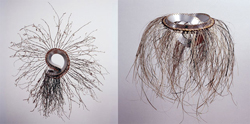
Benjamin Aranda (American, b. 1973), Chris Lasch (American, b. 1972), Terrol Dew Johnson (Tohono O'odham, b. 1973). Left: Knot Basket 1. 2006. Aluminum, branches, and sinew; right: Knot Basket 2. 2006. Aluminum, bear grass, and sinew. Gift of the Committee for Architecture and Design

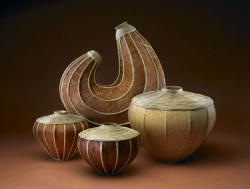
Benjamin Aranda (American, b. 1973). Chris Lasch (American, b. 1972). Terrol Dew Johnson (Tohono O'odham, b. 1973)
One of the new arrivals at MoMA is Baskets, a series of three delicate, sculptural designs resulting from a collaboration between the architectural studio Aranda\Lasch and Terrol Dew Johnson, a nationally recognizedTohono O'odham basket weaver. In 2004, Benjamin Aranda and Chris Lasch were recent graduates of Columbia University’s architecture program, where they had been knee-deep in digital design, software, and computer screens. That winter, they made a visit to the National Museum of the American Indian in New York, where they happened upon an exhibition dedicated to the art of basket weaving. The pair recognized almost immediately in these ancient and beautiful analog craft processes a connection to the digital algorithms with which they were experimenting. Their resulting project, Baskets, explores algorithmic design as a continuum stretching from the computer-aided techniques in design and architecture — outlined in their influential 2005 manifesto, Pamphlet Architecture #27: Tooling — back through the creative traditions of one of the world’s oldest material practices.
These works were created via a reciprocal and extended collaborative partnership between them and Johnson, whose work they saw for the first time in the weaving exhibition. Over many months, Aranda and Lasch digitized patterns described by Johnson and, in response, Johnson made physical the digital algorithms provided by the architects. The trio even went out into the Arizona desert together to collect materials for the works in the series that Johnson made. (Others were 3-D printed.)
Together, they produced a collection of experimental woven constructions that highlight parallels between craft, design, and architecture, digital and analog algorithm-based processes, repetitive manual and automated practices, and different methods of knowledge sharing. Rooted in the tradition of experimental architecture and design practice, we can think of these works like three-dimensional architectural exploratory sketches that investigate how advanced computational methods and ancient algorithmic codes can be used to foster contemporary architecture and design.
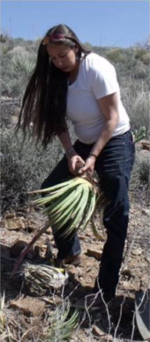
Carrie Cannon, Kiowa
Carrie Cannon is a member of the Kiowa tribe of Oklahoma and is also of Oglala Lakota descent. She has a B.S. in Wildlife Biology, and an M.S. in Resource Management. She began working as a tribal biologist for the Hualapai Tribe of Peach Springs, Arizona in 2005 where she began the creation of an intergenerational ethnobotany program for the Hualapai community. Carrie Cannon is currently employed as an Ethnobotanist for the Hualapai Department of Cultural Resources. She administers a number of department projects and programs which promote the intergenerational teaching of Hualapai ethnobotanical knowledge. She works towards both preservation as well as revitalization, focusing her energy on ensuring tribal ethnobotanical knowledge persists as a living practice and tradition.
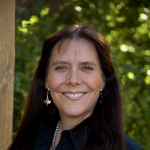
Lois Ellen Frank, Kiowa
A Santa Fe, New Mexico based chef, author, Native foods historian and photographer Lois Ellen Frank was born in New York City and raised on Long Island, New York with her father's side of the family. She is from the Kiowa Nation on her mother's side and Sephardic on her father's side. Her first career experiences were as a professional cook and organic gardener.
Lois has spent over 25 years documenting foods and life ways of Native American tribes from the Southwest. This lengthy immersion in Native American communities culminated in her book, Foods of the Southwest Indian Nations, featuring traditional and contemporary recipes. It won the James Beard Award in the Americana category and was the first Native American book to win the award. She has worked with world-renowned chefs, scientists and academicians and collaborated with them to publish many culinary posters and cookbooks. She has worked with National and International advertising agencies as well as many editorial clients as a chef and a photographer.
Lois received her Ph.D. from the University of New Mexico in Culinary Anthropology in July 2011. Her dissertation entitled The Discourse and Practice of Native American Cuisine: Native American Chefs and Native American Cooks in Contemporary Southwest Kitchens, will also be one of her next books, tentatively entitled The Turquoise Plate. She received her Master of Arts in Cultural Anthropology in May, 1999 where she focused on the importance of corn as a common thread to all Indigenous tribes throughout the Americas.
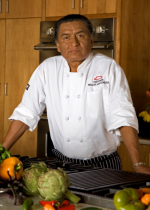
Walter Whitewater, Diné
Walter Whitewater grew up in Pinon, Az on the Navajo Nation. A self-taught chef, he was the culinary advisor for the James Beard award-winning book Foods of the Southwest Indian Nations. He also the Culinary Consultant and Chef de Cuisine at Red Mesa Cuisine, LLC, a unique catering company that specializes in Native American food that are locally and nationally sourced.
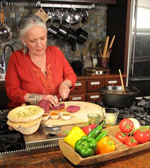
Loretta Barret Oden, Potawatomi
Loretta Barret Oden began her passionate relationship with food as a small child at the side of her mother, grandmothers, and aunts in Oklahoma. She spent most of her adult years raising her family, cooking, studying, teaching and adapting recipes to preserve the culinary legacy of her upbringing. In the 1990s, she and her son, the late chef Clayton Oden, opened the Corn Dance Cafe, the first restaurant to showcase the amazing bounty of food indigenous to the Americas.
She has been featured on Good Morning America, The Today Show, In Food Today and Cooking Live, and in the following publications, The New York Times, Prevention Magazine, Sunset, Veranda, Food Arts, and National Geographic Traveler. She also served as a guest chef in the Robert Mondavi Great Chefs series and the 2006 Taste3 Celebration in Napa and on Barbara Pool Fenzl’s PBS series, Savor the Southwest.
Loretta was the host of the Emmy award winning 5-part PBS series, Seasoned with Spirit, a culinary celebration of America's bounty combining Native American history and culture with delicious, healthy recipes inspired by indigenous foods.
Mark Bahti
Mark has a Master of Arts in American Indian Studies and a PhD in Anthropology. Throughout Mark’s career he has lectured, appraised and served as a judge at numerous Indian Arts and Craft events throughout the country and is the owner of Bahti Indian Arts in Tucson, Arizona. He leads tours of archeological sites and of Indian artists’ studios in New Mexico and Arizona and is an expert in his field. Mark has published a wide array of books, articles and professional papers focused on Indian art and crafts throughout his professional career. Mark serves as a board member for the Amerind Foundation and has received Honors as the Distinguished Citizen Award from the University of Arizona Alumni Association, Fellow from the Society for Applied Anthropology and Fellow of the Royal Anthropological Institute of London.
Ruby Chimerica, Hopi
Ruby Chimerica (Hopi) is from the Third Mesa village of Bacavi, located on the Hopi Reservation in Arizona. She specializes in hands-on demonstrations of Hopi basket weaving and the preparation of traditional Hopi foods. The piki bread-making tradition is strongly connected to family. The stone on which the bread is baked is passed down from generation to generation. Piki is used at community celebrations, and at festival and dances. Its dark grayish-blue color and unique flavor is due to the use of blue corn and culinary ash.

Terry DeWald
Terry DeWald, author of The Papago Indians and Their Basketry, has been a prominent dealer, lecturer, appraiser and author in American Indian Art for more than 35 years. His father was a journalist and photographer who covered the Southwest for Time and Life magazines and other national publications. His mother was one of the founding members of the Heard Museum Guild. Mr. DeWald's degrees are from the Univeristy of Arizona where he studied history of the American West, anthropology and Native American history. He has done appraisals for the Southwest Museum in Los Angeles, the Philbrook Museum in Tulsa, the Heard Museum in Phoenix, and the Arizona state Museum in Tucson. He has given presentations for Smithsonian groups, archeological seminars, major art auctions, exhibitions, and has spoken at many of our National Parks & Monuments. Mr. DeWald in an active trader, buying art from over 100 Native Americans each week. He is a major dealer and collector of antique Native American art and is a full member of ATADA (Antique Tribal Art Dealers Association) and has advised major auction houses such as Christie's, Bonhams & Butterfields, and Sotheby’s.
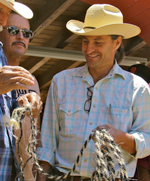
Jesús García
Jesús García was born and raised in Magdalena de Kino, Sonora, Mexico. Since 1991 he has been associated with the Arizona-Sonora Desert Museum, where he is an Education Specialist, teaching natural history and cultural programs throughout southern Arizona and northern Sonora. He holds a degree in Ecology and Evolutionary Biology with a minor in Cultural Anthropology. He has been Director of the Kino Heritage Fruit Trees Project for over ten years and his many interests include conservation biology, art, cultural ecology, language, music and gardening.
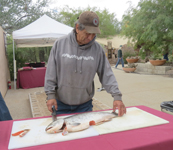
Ed Mata, Yurok
Luis Barragan, Instructor
Annetta Koruh, Hopi










